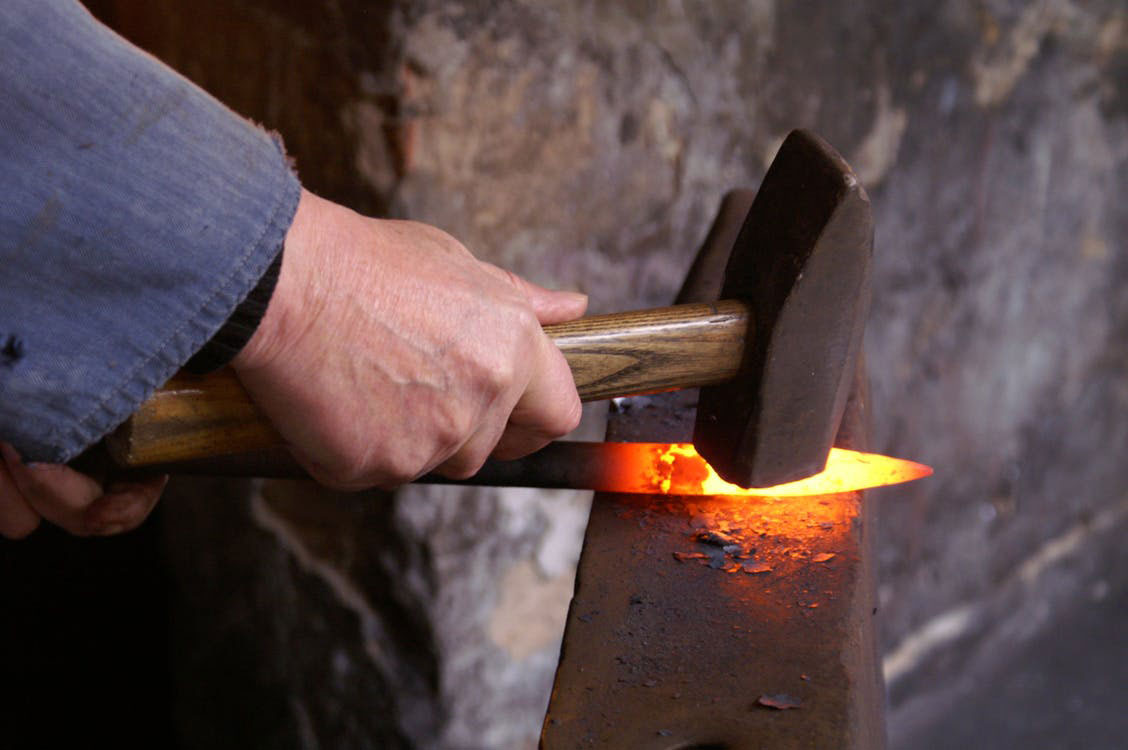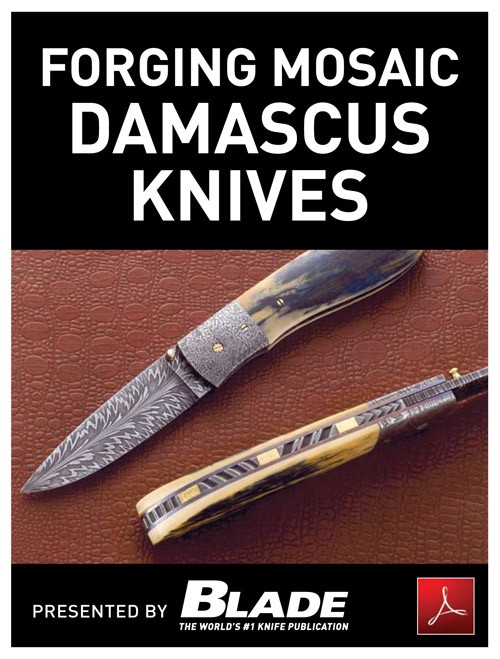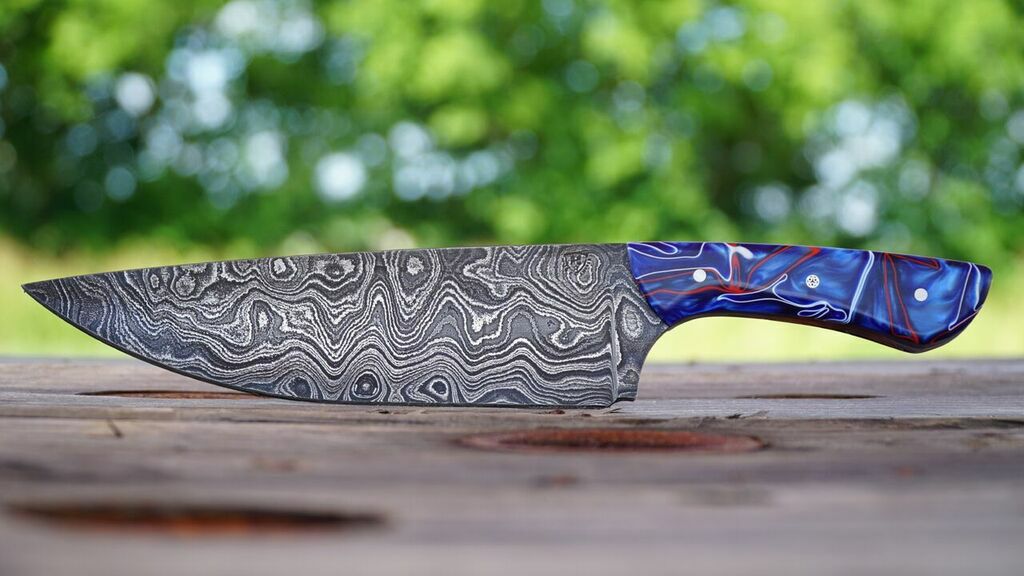
The collaborations of Gil Hibben and Paul Ehlers speak volumes without using words.
When the great design prowess of Paul Ehlers and the incomparable shop skills of BLADE Magazine Cutlery Hall-of-Fame® member Gil Hibben merged some 40 years ago, they produced a synergy seldom seen, elevating the knife industry to a new plane of creativity in the realm of the fantasy piece.
Following a trail blazed early by the likes of W.W. “Bud” Cronk, the pair brought vision and glimpses of other worlds from the realm of theory and the ephemeral to tangible, captivating and thoroughly gripping. During a custom knifemaking career that has spanned nearly seven decades, Hibben has been recognized as the author of extraordinary work, designing the first Browning hunting knives in 1968, earning a rightful place in the Cutlery Hall of Fame, and creating legendary knives for famed actor Sylvester Stallone in the Rambo film franchise, as well as the American Kenpo Knife for Gil’s martial arts sensei, Ed Parker.

Ehlers is well known for his work in film, writing, voice, design and illustration. He was hired to produce a poster illustration for the 1981 cult classic film Madman and found himself cast as the title character, delivering an amazing performance. Versatility has been his hallmark through the years, expressing his artistic talent through a variety of media. His interests are literally boundless and his talents have been displayed across a broad spectrum of the arts.
It was Ehlers’ wide range of interests that led to a fortuitous conversation and brought about the most renowned collaboration in fantasy knife history—and one of the greatest industry wide in custom knives. “It arose from creativity on both parts,” attested Linda Hibben, Gil’s wife and a key individual through the years of the joint effort. “It was intended to create things that were never seen before in the knife industry, taking up the challenge to be true artists.”

Paul remembered, “Gil Hibben’s knives were featured in every martial arts magazine that I read. I was familiar with the Parker knife and wanted badly to buy one of Gil’s knives. So, by the mid-1980s I had saved enough money and placed an order with him.” Hibben produced a custom survival bowie with a 10-inch blade, characteristic sawteeth reminiscent of his Rambo knives, and a handle in the style of the Parker knife. Pleased with the finished product, Paul told Gil that he was a designer and illustrator with a particular love for fantasy characters. He commented that he had always wanted to see his characters with stylized knives and swords to complement their presentation.
Gil responded enthusiastically to Paul’s offer of sending an illustration for his review. “Love to see one!” was the reply. Game on.
Ehlers calls the initial brush with collaboration a “chance meeting of kindred souls.” The illustration led Gil to the shop with the goal of producing a knife named the Shark. A short time later, the designer asked about the maker’s progress. Hibben’s response was electrifying: “I already made it and sold it!”

In a short time, the creative tandem gained momentum. Interestingly, their success may be linked to the fact that Paul does not make knives. “I admire, collect, use and draw them,” he commented. “But Gil Hibben makes knives.” By the time Gil and Paul brought their Dragonfly creation to the 1983 Knifemakers’ Guild Show, there was excitement but also some trepidation. “We were concerned about how to price it, whether it would sell and how it might be received,” Paul recalled. “Gil suggested that we put a price of $3,000 on it, and such a premium was almost unheard of in those days. But it sold!”
Ehlers had conceived the Dragonfly, drawn it on paper, rolled it up, and placed it in a mailing tube addressed to Hibben. When it reached him, Gil pursued the project with gusto even though the effort in itself was unprecedented. “Nothing like this had ever been made,” Paul advised. “But that didn’t stop him. He huffed and he puffed, he ground and he buffed and emerged from his shop holding the new Dragonfly.”
Unseen Realms

Through the years the Hibben-Ehlers team flourished, one teammate with ideas and the other with the astonishing ability to grind steel and finish creations that brought visions of light, darkness, other worlds, and realms unseen as the tangible, real and dazzling works that are known the world over. Paul’s imagination effectively pushed Gil to new heights of creativity. The designer’s mind had remained fortuitously free to imagine the fantastic and the elements of the outer limits of innovation
“My mind was left open to create,” Paul explained. “If I knew then what I know now it is possible my concepts may have been restricted by the ‘impossible’ factor. I know now what other makers mean when they ask Gil, ‘How the hell did you make that?’”

Hibben, on the other hand, has stood up to the challenge and then some, delivering time after time. As the collaboration aged like fine wine to more than 30 years, it had produced more than 40 pieces—knives that came to life, from the mist of imagination to the gleam of steel, sculpture and artistry. According to Linda, Gil once said, “I loved the challenges and making these pieces, each and every one of them. They made my creativity and skills set on fire! Paul’s dreams are my nightmares!”
Looking back, a turning point for the Hibben-Ehlers collaboration occurred in the 1990s when a representative of the Sultan of Brunei contacted Paul with the shocking pronouncement that his employer wished to purchase many knives produced by the pair, with the added kicker that “money is no object.” It was a compliment of the highest order and led to some remarkable achievements.

Throughout the collaborative years, Linda has been a tremendous contributor to the success of the enterprise. Gil is approaching his 90th birthday and suffered a stroke in the spring of 2016. However, he has been resilient and remains in touch with the custom knife community while Linda assists with his communications. Gil has stayed active in the shop and keeps up to date on the happenings in the knife community. “He still goes to his shop and even oversees knifemaking classes to this day,” Linda noted. “The only lingering effect from the stroke is he has trouble with words and numbers once in a while. He has no major lingering side effects other than that.” Ehlers, meanwhile, is quite busy with numerous endeavors, his creative energy as effervescent as ever.

Linda captured the spirit of the great team’s aspirations, commenting, “They wanted knives to be taken to another level of art and imagination—to create and make sharpened shapes in steel that had not been done or seen before, and show that thinking ‘outside the box’ and making those creations into tangible works of edged art took a tremendous amount of skill. Just look at some of the grind lines Gil was able to accomplish.”
Showstoppers
Through the lens of knifemaking history and the gleaming facet of fantasy, those who see and admire the vision of Gil and Paul will continue to gaze with wide-eyed wonder at their works, including some of the most famous. The Alien, for example, was created in 1986 from a single piece of 440C stainless steel. “It burst from my mind in 1986,” Paul recalled. “There are a myriad of extra blades, spikes and projections Gil calls ‘long horns,’ plus hooks and a leather arm gauntlet.”

Linda noted, “The Alien was our biggest showstopper. This one got more attention at knife shows than any other. We allowed people to reach their arm into it and ‘wear’ the Alien, and in every instance the person’s entire demeanor changed. It was like they became powerful, and the smiles on their faces when posing for photos was and is priceless. Gil made a total of five of these Aliens, each one a bit different. Number five rests in our private collection, and to this day when people come over and actually hold or ‘wear’ it, the magic is still there. They become a ‘Master of the Universe’ for those few minutes.”
An early classic, the Elf Dirk was produced in 1984, and the image sprang from Ehlers’ fascination with gnomes, elves, giants and other mythical creatures. Hibben wrought its sleek lines in 440C with a reconstituted coral handle, 14-karat gold and garnets. A spider dangles from its web, carefully crafted in a crevice of the handle. Naja, completed in 1993, remains a favorite. The undulations of the cobra are almost physically felt as Norman Leigh’s sculpted bronze cast of the serpent rises above the grip, gazing with inset cat’s eye jewels for eyes and baring fangs. Gil’s expertise is on full display in this tour de force, and Paul considers Naja perhaps the finest art knife the two have ever brought to life.
Artists, innovators, visionaries and friends, Gil and Paul have created a body of work that speaks volumes without words, just towering interpretation and storytelling in thought and grind, idea and finish. Those who contemplate their many completed projects are often left speechless as well, awed by the intricacy, the timeless, tantalizing and touching renderings of their complementary experience.
More On Custom Knives:
- Eastern European Custom Knives
- Latin Americab Custom Knife Makers
- What Do Judges Look At In Custom Knife Competitions?
- What Defines The Best Custom Hunting Knives?
 NEXT STEP: Download Your Free KNIFE GUIDE Issue of BLADE Magazine
NEXT STEP: Download Your Free KNIFE GUIDE Issue of BLADE Magazine
BLADE’s annual Knife Guide Issue features the newest knives and sharpeners, plus knife and axe reviews, knife sheaths, kit knives and a Knife Industry Directory.Get your FREE digital PDF instant download of the annual Knife Guide. No, really! We will email it to you right now when you subscribe to the BLADE email newsletter.






